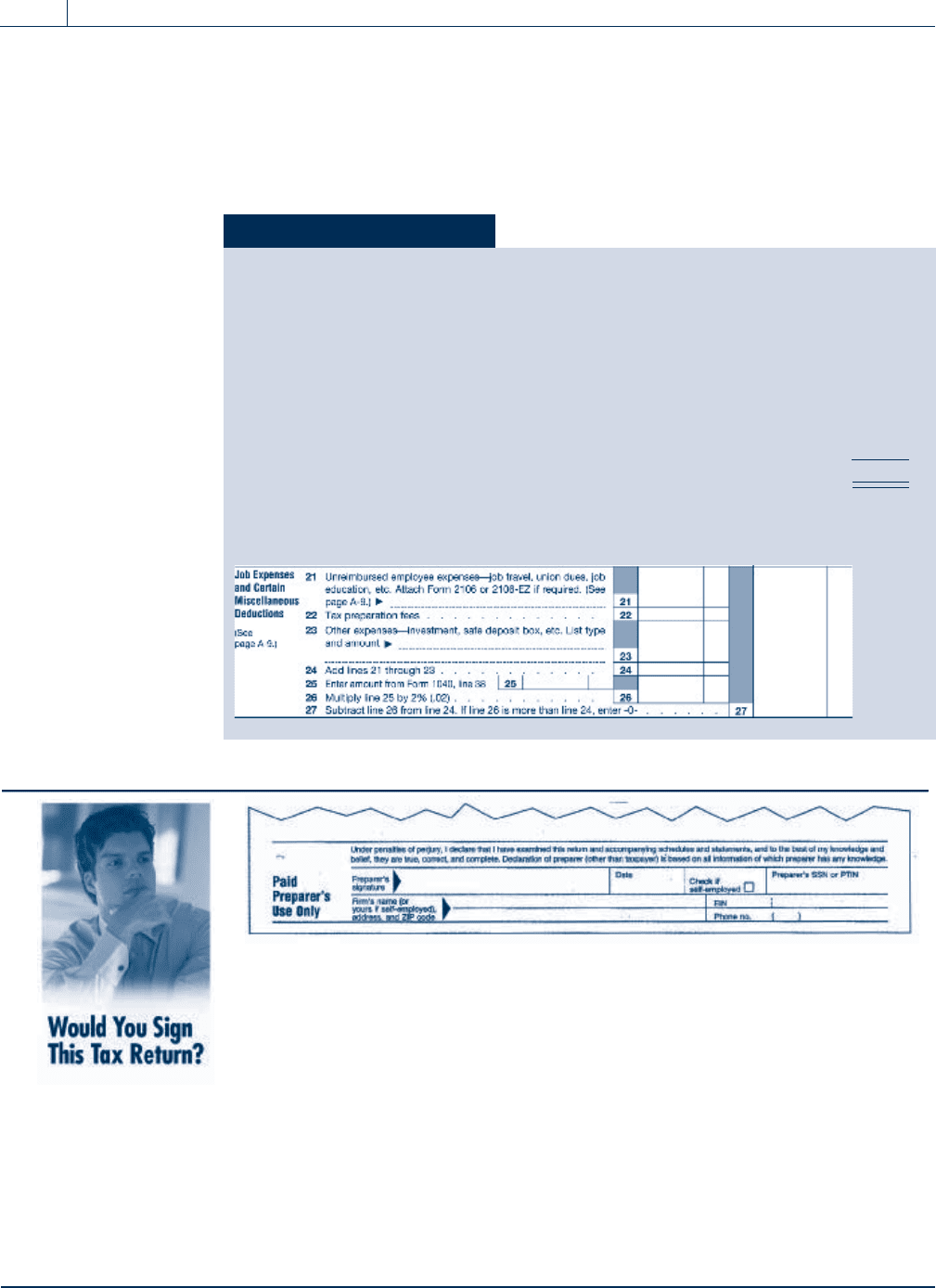Whittenburg Gerald E., Altus-Buller Martha. Income Tax Fundamentals
Подождите немного. Документ загружается.


EXAMPLE Sam graduated from college in 2009, taking a job with a salary of
$45,000 per year. During 2010, he pays $2,500 interest on qualified
education loans. Because his income is below the $60,000 phase-out
amount for individual taxpayers, he can deduct the full $2,500 of the
interest in arriving at adjusted gross income on his 2010 tax return. If
he had paid more than $2,500 in interest, the excess would be consid-
ered nondeductible consumer interest. N
If taxpayers borrow for personal purposes, such as buying a new automobile,
they will likely be better off taking out a home equity loan rather than consumer
debt. Th e interest on a home equity loan will be deductible (so long as there is
no more than $100,000 of total home equity debt and the fair market value
of the residence exceeds the acquisition debt and the home equity debt com-
bined), while the interest on a consumer loan for the same purpose will not be
deductible.
Investment Interest
To prevent abuses by high-income taxpayers, the Internal Revenue code includes a pro-
vision limiting the deduc tion of investment interest expense. This provision limits the
amount of deductible interest on loans to finance investments. The investment interest
deduction is limited to the taxpayer’s net investment income. Net investment income
is income such as dividends and interest, less investment expenses other than interest.
Special rules apply to dividends and capital g ains included as investment income due
to their preferential tax rates. The general rule is that they may only be included as
investment income if the taxpayer chooses to calculate tax on them at ordinary income
rates. Any disallowed interest expense is carried over and may be deducted i n succeeding
years, but only to the extent that the taxpayer’s net investment income exceeds invest-
ment interest for the year.
EXAMPLE Karen borrows $150,000 at 12 percent interest on January 1, 2010.
The proceeds are used to purchase $100,000 worth of raw land and
a $50,000 CD. During 2010, the CD pays interest of $1,500. Karen
incurs expenses attributable to the investment property of $500.
Of the $18,000 (12% of $150,000) interest incurred in 2010, $1,000
is deductible. The deduction is computed as follows:
Net investment income:
Investment income $1,500
Less: inve stment expenses
(500)
Interest deductible in 2010
$1,000
The unused deduction of $17,000 ($18,000 $1,000) is carried
forward and may be used as an interest deduction in future years,
subject to the net investment income limitation. N
Section 5.3
Interest 5-11
Copyright 2010 Cengage Learning. All Rights Reserved. May not be copied, scanned, or duplicated, in whole or in part. Due to electronic rights, some third party content may be suppressed from the eBook and/or eChapter(s).
Editorial review has deemed that any suppressed content does not materially affect the overall learning experience. Cengage Learning reserves the right to remove additional content at any time if subsequent rights restrictions require it.

SECTION 5.4 CONTRIBUTIONS
To encourage indiv iduals to be socially responsible, the Internal Revenue code allows a
deduction fo r charitable contributions. To be deductible, the donation mu st be made in
cash or property; the value of free use of the taxpayer’s property by the charitable organi-
zation does not qualify. In addition, out-of-pocket expenses related to qualified charitable
activities are deductible as charitable contributions. For example, a taxpayer who drives his
car 200 miles during 2010 to take a church group to a meeting out of town would be
allowed a charitable deduction of $28 (200 miles 14 cents per mile).
EXAMPLE Lucille allows the Red Cross to use her building rent-free for 8 months.
The building normally rents for $600 per month. There is no deduction
allowed for the free use of the building. N
To be deductible, the donation must be made to a qualified recipient as listed in the tax
law, including:
1. the U.S., a state, or political subdivision thereof, if the donation is made for exclu-
sively public purposes (such as a contribution to pay down the federal debt);
2. domestic organizations formed and operated exclusively for charitable, religious, edu-
cational, scientific, or literary purposes, or for the prevention of cruelty to children or
animals;
3. church, synagogue, or other religious organizations;
4. war veterans’ organizations;
5. civil defense organizations;
Self-Study Problem 5.3
Dorothie paid the following amounts during 2010:
Interest on her home mortgage $9,250
Service charges on her checking account 48
Visa and Mastercard interest 168
Automobile loan interest 675
Interest on a loan to buy stock 1,600
Credit investigation fee for a loan 75
Dorothie’s residence has a fair market value of $150,000. The mortgage
balance is $125,000, which is a loan that was acquired in 1998 when she pur-
chased her home. No additional debt was incurred as a result of the refinanc-
ing of the home mortgage. Dorothie has $1,000 of net investment income.
Use the following interest section of Schedule A to calculate Dorothie’s interest
deduction for the current year.
5-12 Chapter 5
Itemized Deductions and Other Incentives
Copyright 2010 Cengage Learning. All Rights Reserved. May not be copied, scanned, or duplicated, in whole or in part. Due to electronic rights, some third party content may be suppressed from the eBook and/or eChapter(s).
Editorial review has deemed that any suppressed content does not materially affect the overall learning experience. Cengage Learning reserves the right to remove additional content at any time if subsequent rights restrictions require it.

6. fraternal societies operating under the lodge system, but only if the contributi on is
used for one or more of the charitable purposes listed in (2) above; and
7. certain nonprofit cemetery companies.
The following contributions are not deductible:
1. Gifts to nonqualified recipients, for example, needy in dividuals, social clubs, labor
unions, international organizations, and political parties
2. Contributions of time, service, the use of property, or blood
3. Contributions where benefit is received from the contribution, for example, tuition at
a parochial schoo l
4. Wagering losses, such as church bingo and raffles
If a taxpayer has doubt as to the deductibility of a payment, he or she should review the
IRS’s Cumulative List of Organizations, Publication No. 78.
If cash is donated, the deduction is equal to the amount of the cash. For donated prop-
erty other than cash, the general rule is that the deduction is equal to the fair market value
of the property at the time of the donation. The fair market value is the price at which the
property would be sold between a willing buyer and seller . There is an exception to this
general rule for property that would have resulted in ordinary income or short-term capital
gain had it been sold on the date of the contribution. In that situation, the deduction for
the contribution is equal to the property’s fair market value less the amount of the ordinary
income or short-term capital gain that would have resulted from sale of the property. If sale
of the property would have produced a long-term capital gain, the deduction is generally
equal to the fair market value of the property. However, the fair market value is reduced by
the amount of the potential long-term capital gain, if the donation is made to certain pri-
vate nonoperating foundations or the donation is a contribution of tangible personal prop-
erty to an organization that uses the property for a purpose unrelated to the organization’s
primary purpose.
EXAMPLE Jeano B. donates a painting acquired 5 years ago at a cost of $4,000
to a museum for exhibition. The painting’s fair market valu e is
$12,000. If Jeano had sold the painting, the difference betwee n the
sales price ($12,000) and its cost ($4,000) would have been a long-term
capital gain. The deduction is $12,000, and it is not reduced by the
amount of the appreciation, since the painting was put to a use
related to the museum’s primary purpose. If the painting had been
donated to a hospital, the deduction would be $4,000, which is
$12,000 less $8,000 ($12,000 $4,000), the amount of the long-term
capital gain that would have resulted if the painting had been sold. N
Rather than donate cash, taxpayers may wish to donate appreciated stock or
other appreciated property to charity. If the gift is properly structured, a full
deduction may be taken for the fair market value of the donated property, while
tax on the appreciation is avoided completely.
Percentage Limitations
Generally, a taxpayer may not deduct total contributions in excess of 50 percent of the tax-
payer’s adjusted gross income. This 50 percent limitation applies to donations to all public
charities, all private operating foundations, and private nonoperating foundations if they
Section 5.4
Contributions 5-13
Copyright 2010 Cengage Learning. All Rights Reserved. May not be copied, scanned, or duplicated, in whole or in part. Due to electronic rights, some third party content may be suppressed from the eBook and/or eChapter(s).
Editorial review has deemed that any suppressed content does not materially affect the overall learning experience. Cengage Learning reserves the right to remove additional content at any time if subsequent rights restrictions require it.

distribute their contributions to public charities within a specified time period. Gifts to
other qualified organizations, such as certain private nonoper ating foundations, fraternal
societies, and veterans’ organizations, as well as gifts for the use of an organization, are lim-
ited to 30 percent of adjusted gross income. Special rules apply to contributions of long-
term capital gain property. If the full fair market value of a gift of long-term capital gain
property is deducted, and the contribution is to a 50 percent organization, the contribution
is subject to the 30 percent limit. Taxpayers may avoid the 30 percent limit on contribu-
tions of long-term capital gain property by electing to reduce the value of the property by
the appreciation that would otherwise be long-term capital gain, in which case the 50 per-
cent limitation applies. Long-term capital gain property donated to other than a 50 percent
organization is subject to a 20 percent of adjusted gross income limitation.
EXAMPLE Carol donates publicly traded stock worth $15,000 to a qualified
50 percent charity. The original purchase price of the stock, 10 years
ago, was $10,000. Because the stock is a gift of long-term capital gain
property, Carol’s deduction is limited to 30 percent of her adjusted
gross income. Given that Carol’s AGI is $20,000, she may take a deduc-
tion for $6,000 (30% of $20,000) and may carry the remaining $9,000
($15,000 $6,000) forward to the following year. Alternatively, Carol
may deduct the original $10,000 cost of the stock using the 50 per-
cent of AGI rule, which would give her a $10,000 deduction in the
current year. Even though she would have a larger deduction in the
current year, she would lose $5,000 of her potential charitable contri-
bution deduction by choosing this alternative. N
Generally, contributions to 50 percent organizations are deducted first, followed by
contributions subject to the 30 percent and 20 percent limitations, respectively. Contribu-
tions subject to the 30 percent and 20 percent of adjusted gross income limitations are
allowed only to the extent that they do not exceed 50 percent of adjusted gross income
reduced by the amount of contributions subject to the 50 percent limitation.
EXAMPLE In March of 2010, Grace contributes $15,000 in cash to a public uni-
versity. In addition, at the same time she donates $7,000 in cash to an
organization subject to the 30 percent of adjusted gross income limi-
tation. Grace has adjusted gross income in 2010 of $35,000. Her con-
tribution deduction is determined as follows:
Adjusted gross income $35,000
50%
50% limitation 17,500
Allowable 50% limitation
contributions
(
15,000)
Excess 50% limitation
2,500
Maximum 30% contributions:
Lesser of $2,500 or 30%
of adjusted gross income,
$10,500
2,500
Total deductible contrib utions:
50% contributions 15,000
30% contributions
2,500
Total
$17,500
N
5-14 Chapter 5
Itemized Deductions and Other Incentives
Copyright 2010 Cengage Learning. All Rights Reserved. May not be copied, scanned, or duplicated, in whole or in part. Due to electronic rights, some third party content may be suppressed from the eBook and/or eChapter(s).
Editorial review has deemed that any suppressed content does not materially affect the overall learning experience. Cengage Learning reserves the right to remove additional content at any time if subsequent rights restrictions require it.

In general, any contributions not allowed due to the adjusted gross income limitations
may be carried forward for 5 years. The contributions may be deducted in the carryover
years subje ct to the same percentage of income limitations which were applicable to the
contributions in the yea r they originat ed. Contribution carryovers are allowed only after
taking into account the current year contributions in the same category.
A tax lawyer pleaded guilty to tax evasion in Federal District Court for substan-
tially overstating his charitable contributions. He told an IRS agent that he put
$500 in cash into the church collection basket each week. His pastor, however,
said that the parish didn’t take in $500 in currency at all of its masses combined.
Substantiation Rules
Taxpayers should keep records, receipts, cancelled checks, and other proof of charitable
contributions. For gifts of property, for example clothes and household goods given to
the Salvation Army, totaling over $500, the taxpayer m ust attach a Form 8283 to his or
her return giving the name and address of the donee, the date of the c ontribution, a
description of the property, the approximate date of acquisition of the property, and certain
other required information. For large gifts of property worth $5,000 or more, the donor
must also obtain and submit an appraisal.
No charitable deduction is allowed for contributions of $250 or more unless the tax-
payer substantiates the contributions with written acknowledgments from the recipient
charitable organizations. The acknowledgments must contain this information:
The amount of cash and a description (but not the value) of property other than
cash contributed.
Whether the charitable organization provided any goods or services in consider-
ation, in whole or in part, for any property contributed. (If a payment is partly a
gift and partly in consideration for goods or services prov ided to the donor, it is
a ‘‘quid pro quo contribution’’ and special rules apply.)
A description and good-faith estimate of the value of any goods or services provided
the donor, or, if the goods and services consist solely of intangible religious benefits,
a statement to that effect. Intangible religious benefits are any benefits provided by
organizations formed exclusively for religious purposes and not generally sold in a
commercial setting. For example, attendance at church is considered an intangible
religious benefit while attendance at a private religious school is not. A donation
made at a church service is generally considered a charitable contribution while
tuition paid to a private religious school is not considered a charitable contribution.
Since 2007, taxpayers donating amounts of cash smaller than the $250 limit are required to
keep a bank record (cancelled check) or a written communication from the charity. Taxpayers
who itemize deductions should use checks instead of cash for church and similar cash donations.
Gifts of clothing and household items (including furnishings, electronics, appliances,
and linens) are also subject to another requirement. They must be in ‘‘good’’ condition
or better to qualify for a deduction. Also, charitable deductions may be denied for contri-
butions of items with minimal value, such as used socks and undergarments. The rules for
noncash contributions were passed because some taxpayers significantly overstated the
value of noncash contributions deducted.
No particular form is prescribed for the written acknowledg ment, nor does the donor’s
Social Security number have to be contained on the acknowledgment. It may be a receipt,
letter, postcard, or computer form. The acknowledgment must be obtained on or before
Section 5.4
Contributions 5-15
Copyright 2010 Cengage Learning. All Rights Reserved. May not be copied, scanned, or duplicated, in whole or in part. Due to electronic rights, some third party content may be suppressed from the eBook and/or eChapter(s).
Editorial review has deemed that any suppressed content does not materially affect the overall learning experience. Cengage Learning reserves the right to remove additional content at any time if subsequent rights restrictions require it.

the date on which the tax return for the tax year of the contribution is filed, or by the due
date (plus extensions) if it is earlier than the actual filing date.
Taxpayers donating used vehicles to charity cannot claim a deduction greater than the
amount fo r which the charity actually sells the vehicle. The charity will be required to
provide the resale information on Form 1098-C to taxpayers donating vehicles. The
same rule also applies to boats and planes donated to charity. Taxpayers must attach
Form 1098-C to their tax return to substantiate the deduction. Taxpayers may claim
an estimated val ue for the auto if the charity does not sell it but rather uses it or gives
it to a n eedy individual. The charity must certify t hat an exception applies if no resale
amount is provided on Form 1098-C.
Tightening the rules for the charitable donations of cars caused the dollar value
of the deductions to drop by 80 percent in 2005, the first year under the new
rules. The dollar amount of charitable deductions for automobiles was approx-
imately $2.4 billion in 2004 and only $470 million in 2005.
For quid pro quo contributions (donations involving the receipt of goods or services by
the donee), written statements (disclosures) are required from the charitable organization
to donors making contributions of more than $75. The disclosures need not be individual
letters to donors; they simply provide the donors with good-faith estimates of the value of
the goods or services and inform the donors that only the amounts of the contributions in
excess of the value of the goods or services are deductible for federal income tax purposes.
A charitable organization knowingly providing false written acknowledgments is subject
to penalty (generally $1,000) for aiding and abetting in the understatement of tax liability.
A penalty of $10 per contribution per event, capped at $5,000, may be imposed on charities
failing to make the required disclosures for quid pro quo contributions.
A cash basis taxpayer may charge year-end expenses on a credit card and still
deduct the expenses even when payment on the credit card is not made until the
next year. Instead of paying medical bills, charitable contributions, or even prop-
erty taxes by check at year-end, the taxpayer may prefer to charge the expense.
Note, however, that the credit card may not be one issued by the company supply-
ing the deductible goods or services, but must be a card issued by a third party.
Self-Study Problem 5.4
During 2010, Eric gave $260 to his church for which he received a written
acknowledgement. He also has receipts for $75 given to the Boy Scouts of Amer-
ica and $125 given to the Mexican Red Cross. Eric gave the Salvation Army old
clothes worth $150 (original cost $1,700). Last year Eric had a large contribution
and could not deduct $800 of it due to the 50 percent limitation. This year Eric’s
adjusted gross income is $21,325. Use the Gifts to Charity section of Schedule A
below to calculate Eric’s deduction for the current year.
5-16 Chapter 5
Itemized Deductions and Other Incentives
Copyright 2010 Cengage Learning. All Rights Reserved. May not be copied, scanned, or duplicated, in whole or in part. Due to electronic rights, some third party content may be suppressed from the eBook and/or eChapter(s).
Editorial review has deemed that any suppressed content does not materially affect the overall learning experience. Cengage Learning reserves the right to remove additional content at any time if subsequent rights restrictions require it.

SECTION 5.5
CASUALTY AND THEFT LOSSES
Taxpayers are allowed deductions for casualty and theft losses. The deductions may be
itemized deductio ns or, if related to a busin ess, deductio ns for adjusted g ross income. A
casualty is a complete or partial destruction of property resulting from an identifiable
event of a sudden, unexpected, or unusual nature. Examples of casualties include property
damage from storms, floods, shipwrecks, fires, autom obile accidents, and vandalism. For
damage from weather conditions to be deductible, the condition must be unusual for
the particular region. To qualify as a casualty, an automobile accident must no t be caused
by the taxpayer’s willful act or willful negligence.
EXAMPLE A taxpayer has an automobile that he decides is a lemon, and he
wants to get rid of it. He drives the automobile to the top of a cliff
and pushes it off. Th ere is no casualty loss deduction since the act is
willful. N
Many events do not qualify as casualties. For ex ample, prog ressive dete rioration from
rust or corrosion and disease or insect damage are usually not ‘‘sudden’’ enough to qualify
as casualties. The IRS has held that termite damage is not deductible as a casualty; how-
ever, several courts have in the past allowed the deduction. Indirect losses, such as losses
in property value due to damage to neighboring property, also are not deductible.
A taxpayer left his car in a tow-away zone near his building while he went on
vacation for 2 weeks. When he came back, he discovered that the city had not
only towed his car, but had it crushed. The IRS disallowed his casualty loss because,
it claimed, the taxpayer could have prevented the loss by not parking in a tow-
away zone. Fortunately for the taxpayer, the Tax Court overturned the IRS deter-
mination, saying he could not have known that the city would destroy his car.
If the taxpayer can establish that theft occurred, theft losses are deductible. It is impor-
tant to show that the item was not simply misplaced. Theft losses are deductible in the year
the theft is discov ered, not in the year the theft took place. This is important in cases of
embezzlement, where the theft has gone on over many years and the statute of limitations
has run out on earlier years, otherwise preventing the taxpayer from amending returns for
those years.
As a general rule, casualty losses are deductible in the year of occurrence, but there is an
exception for federally declared disaster area losses. Taxpayers may elect to treat the losses
in a disaster area as a deduction in the year prior to the year the casualty occurred. If a
return has already been filed for the prior year, an amended return may be filed and a
refund claimed for the prior ye ar’s taxes paid. This provision is designed to provide tax-
payers with cash on a more timely basis when they have suffered severe casualties.
EXAMPLE In March of 2010, Amy’s house is damaged by flooding. Shortly there-
after, the President of the United States declares the region a disaster
area. The damage to the house is $6,000 and the loss may be deducted
in 2009 or 2010, even if the 2009 return has already been filed. If Amy
elects to take the deduction in 2009, she may immediately file an
amended tax return for that year, and collect a refund of previously
paid taxes. N
Section 5.5
Casualty and Theft Losses 5-17
Copyright 2010 Cengage Learning. All Rights Reserved. May not be copied, scanned, or duplicated, in whole or in part. Due to electronic rights, some third party content may be suppressed from the eBook and/or eChapter(s).
Editorial review has deemed that any suppressed content does not materially affect the overall learning experience. Cengage Learning reserves the right to remove additional content at any time if subsequent rights restrictions require it.

Measuring the Loss
The amount of the casualty or theft loss is measured by one of the following two rules:
Rule A — The deduction is based on the decrease in fair market value of the property,
not to exceed the adjusted basis of the property.
Rule B — The deduction is based on the adjusted basis of the property.
Rule A applies to the partial destruction of business or investment property and the par-
tial o r complete destruction of personal property, while Rule B applies to the complete
destruction of business and investment property. The cost of repairs is usually used for
the measurement of loss from automobile damage. Repair costs also may be used to mea-
sure losses involving other types of property, but it is not controlling. Indirect costs, such
as clean-up costs, are part of the loss, provided the payments do not restore the property to
better than its previous condition.
EXAMPLE A taxpayer purchased his house 15 years ago for $25,000. Today it is
worth $160,000, and heavy rains cause the house to slide into a can-
yon and be completely destroyed. The taxpayer’s casualty loss deduc-
tion under Rule A is the decrease in fair market value ($160,000 $0)
not to exceed the taxpayer’s basis ($25,000). Thus, the deduction is
limited to $25,000. N
Deduction Limitations
Please note: The $100 floor discussed below may be changed to $500 by Congress during
the final weeks of 2010. Please see the ‘‘A s We Go To Press’’ page and the Whittenburg
companion Web site for updated information.
The tax law includes limitations on the amount of the deduction for casualty and theft
losses related to personal property. Of course, all casualty and theft losses are reduced by
amounts of insurance proceeds. In addition, the amount of each per sonal casualty loss is
reduced by $100 (the floor); the fl oor applies to each casualty or theft, not each year. In
determining the casualty loss deduction, a taxpayer with three separate casualties occurring
during the year must reduce each separate loss by the $100 amount; therefore, no deduc-
tion is allowed for a loss of $100 or less. In addition, taxpayers are allowed a deduction for
personal casualty losses only to the extent the total losses for the year (less floor amounts)
exceed 10 percent of the taxpayer’s adjusted gross income, and then only if the taxpayer
itemizes deductions.
If related to business property, there is no adjusted gross income limitation or dollar
reduction applicable to casualty and theft losses; such losses are deductions for adjusted
gross income. Chapter 8 discusses the reporting of casualty losses on business properties
as well as the reporting of casualty gains where insurance proceeds exceed the basis of
the damaged or stolen property.
EXAMPLE In 2010, John discovers a theft of personal property which had a fair
market value and an adjusted basis of $4,000. For the year, his
adjusted gross income is $24,000. His casualty loss deduction of $1,500
is calculated as follows:
Gross loss $ 4,000
Floor limitation
(100)
Net loss $ 3,900
Less: 10% of $24,000 AGI
(2,400)
John’s casualty loss deduction
$ 1,500
N
5-18 Chapter 5
Itemized Deductions and Other Incentives
Copyright 2010 Cengage Learning. All Rights Reserved. May not be copied, scanned, or duplicated, in whole or in part. Due to electronic rights, some third party content may be suppressed from the eBook and/or eChapter(s).
Editorial review has deemed that any suppressed content does not materially affect the overall learning experience. Cengage Learning reserves the right to remove additional content at any time if subsequent rights restrictions require it.

SECTION 5.6MISCELLANEOUS DEDUCTIONS
Miscellaneous deductions fall into two catego ries, those limited to the extent the total
exceeds 2 percent of adjusted gross income and those with no limitation. The following
common miscellaneous deductions are examples of items which are not subject to the
2 percent of adjusted gross income limitation:
1. Handicapped ‘‘impairment-related work expenses’’
2. Certain estate taxes
3. Amortizable bond premiums (on bonds acquired before October 23, 1986)
4. Terminated annuity payments
5. Gambling losses to the extent of gambling winnings
The common miscellaneous deductions that are subject to the 2 percent limitation include:
1. Unreimbursed employee business expenses and employee business expenses reimbursed
under a nonaccountable plan (e.g., mileage and travel)
2. Investment expenses (e.g., investmen t advice and fees for safe deposit boxes used to
store investment-related papers)
3. Other general miscellaneous itemized deductions (e.g., tax return preparation fees,
union dues, job-hunting expenses, and professional subscriptions)
Investment Expenses
Taxpayers are allowed a deduction for investment expenses directly related to taxable income
or taxable income-producing property. Clerical help and office rent expenses incurred in car-
ing for investments qualify for this deduction. Custodian fees are also deductible, including
fees for holding stocks and bonds, collecting and reinvesting cash dividends and interest, and
record keeping and providing a statement of accounts. Fees paid to a broker or similar agent
to collect taxable interest or dividends are deductible, but fees paid to a broker to acquire
stocks or bonds are not deductible; they are added to the cost of the stocks or bonds. No
deduction is allowed for investment expenses related to tax-exempt income.
Tax Return Preparation Fees
Amounts paid for the preparation of tax returns are deductible in the year paid. For example,
fees paid in 2010 for preparation of a taxpayer’s 2009 tax return are deductible on the 2010 tax
return. Included in this deduction are all regular fees for tax advice and audit representation,
and such items as appraisal expenses to establish the amount of a casualty loss or the fair mar-
ket value of donated property. Credit card convenience fees on tax payments are also included.
Job-Hunting Expenses
In some cases, taxpayers may deduct the cost of seeking employment, including travel and
employment agency fees. To deduct job-hunting expenses, the taxpayer must be seeking
employment in a trade or business in which he or she is currently employed, or, if unem-
ployed, there can be no lack of continuity since the taxpay er’s last job. For example, the
Self-Study Problem 5.5
Vivian Walker (AGI of $25,000) ha s a personal coin collection (acquired 6 years
ago) that has a fair market value of $9,000 and a basis of $6,000. The collec-
tion is stolen by a burglar. Vivian’s insurance pays her $2,900 for the theft loss.
Use Form 4684 Casualties and Thefts on pages 5-21 and 5-22 to report Vivian’s
deduction.
Section 5.6
Miscellaneous Deductions 5-19
Copyright 2010 Cengage Learning. All Rights Reserved. May not be copied, scanned, or duplicated, in whole or in part. Due to electronic rights, some third party content may be suppressed from the eBook and/or eChapter(s).
Editorial review has deemed that any suppressed content does not materially affect the overall learning experience. Cengage Learning reserves the right to remove additional content at any time if subsequent rights restrictions require it.

taxpayer may not terminate employment, get a college degree, and then deduct the cost of
seeking employment after obtaining the degree. The deduction is allowed even if the
attempt to obtain a new job is unsuccessful, but it is not allowed for first-time job seekers
or taxpayers seeking employment in a new trade or business.
Sam Shiraz (age 45), one of your tax clients, is single and the manager of a
bank in Cleveland, OH. Sam feels his life is stagnant and decides to go to
Napa Valley, CA, to look for a job at a bank there. Sam is also a wine collec-
tor. He flies out to Napa Valley and spends 2 weeks looking for a job there.
While in Napa Valley, he looks in the local newspaper’s want ads every day,
talks to an employment agency, and makes a few cold calls on various
banks to see if the y might have any openings for someone with his skills.
Sam spends most of each day visiting wineries. After 2 weeks, Sam cannot
find a job in Napa Valley, so he returns to his old job in Cleveland. The total
cost (transportation, meals, lodging, and wine tasting) of the trip is $3,700.
Sam has receipts and can substantiate these expenses. He is resolute in
claiming the $3,700 as ‘‘job-hunting’’ expenses on Schedule A (subject to
any 2% limitation) on his current year’s tax return. Would you sign the Paid
Preparer’s declaration (see example above) on this return? Why or why not?
Self-Study Problem 5.6
During the current year, Robert has AGI of $35,000 and incurs the following
expenses:
Safe-deposit box ren tal fee (for stocks and bonds) $ 25
Tax r eturn preparation fee 450
Professional dues 175
Trade journals 125
Bank trust fees 1,055
Job-hunting expenses, for employment in the same profession
1,400
Total
$3,230
Assuming Robert is not self-employed, calculate his miscellaneous deduc-
tions on Schedule A of Form 1040.
5-20 Chapter 5
Itemized Deductions and Other Incentives
Copyright 2010 Cengage Learning. All Rights Reserved. May not be copied, scanned, or duplicated, in whole or in part. Due to electronic rights, some third party content may be suppressed from the eBook and/or eChapter(s).
Editorial review has deemed that any suppressed content does not materially affect the overall learning experience. Cengage Learning reserves the right to remove additional content at any time if subsequent rights restrictions require it.
